The 1952 nickel is a nice blend of the modern image we see today and a rare slice of history that we can collect and enjoy. These coins come in different varieties, including proofs, and carry different values when found in uncirculated condition.
Nineteen fifty-two wasn’t a particularly eventful year for coin minting, and there are still plenty of 1952 nickels in circulation today. Despite this, you can still find extremely valuable coins from this year.
This guide focuses on the details of 1952 nickels in general, as well as a more in depth analysis of different series, conditions, and oddities. Keep reading to learn more about what your coin is worth and what to look for when sifting through change.
1952 Nickel Details
- Category: Jefferson Five Cents (1938-1964)
- Mint: Philadelphia, Denver, San Francisco
- Mintage: 115,198,000
- Obverse Designer: Felix Schlag
- Reverse Designer: Felix Schlag
- Composition: 75% Copper; 25% Nickel
- Weight: 0.17637 ounces (5 g)
The obverse of the 1921 nickel features the profile of Thomas Jefferson, the third President of the United States, facing the left of the coin.
Accompanying the president is the inscription “IN GOD WE TRUST” on the left and “LIBERTY” on the right, followed by the year 1952.
The reverse of the coin features Jefferson’s Virginia home and plantation, Monticello (indicated by the inscription of the name below). The reverse also hosts the latin motto “E PLURIBUS UNUM” across the top arch of the coin, as well as the denomination inscription and “UNITED STATES OF AMERICA” cradled in the bottom curve of the nickel.
Also Read: 15 Most Valuable Nickels Worth Money
Value Chart
1952 Nickel Value Chart |
|||||
| Mint Mark | Good | Fine | Extremely Fine | Uncirculated | Proof |
| 1952 | $0.05 | $0.05 | $0.05 | $1.65 | / |
| 1952 D Nickel | $0.05 | $0.05 | $0.05 | $2.53 | / |
| 1952 S Nickel | $0.05 | $0.05 | $0.05 | $0.87 | / |
| 1952 Proof Nickel | / | / | / | / | $18 |
1952 Nickel Value and Varieties Guide
Because Jefferson nickels are still widely circulated today and they aren’t dwindling with any speed, there is little value on any circulated coins from this year. Still, you find that 1952 nickels from different mints carry different values.
Beyond this, you may find 1952 proof nickels that are particularly valuable for a collection.
Ultimately, the value of these coins depends on whether they’ve circulated or not.
1952 No Mint Mark Nickel Value
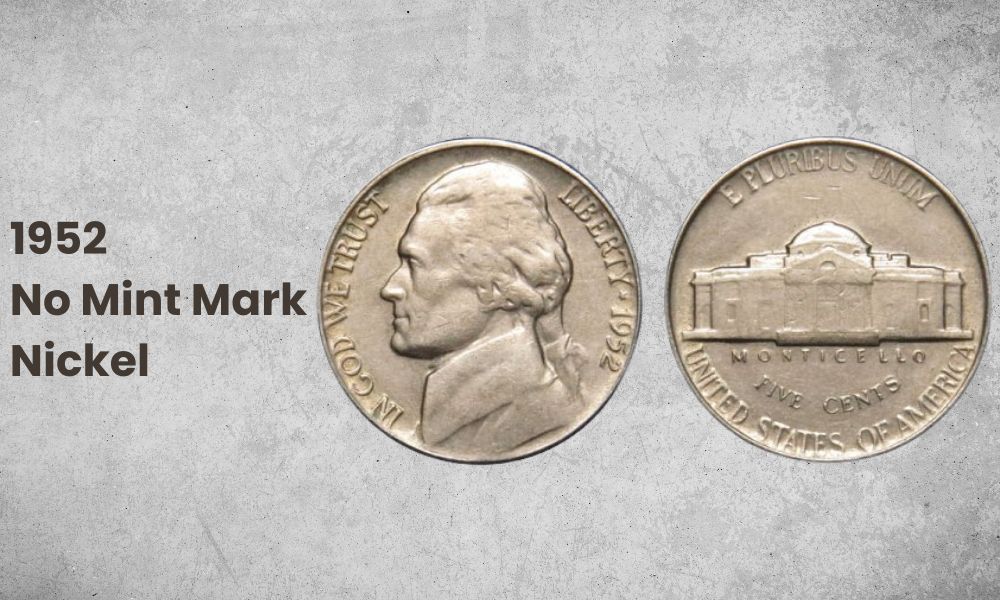
- Type: Jefferson Five Cents (1938-1964)
- Edge: Plain
- Mint Mark: N/A
- Place of Minting: Philadelphia
- Year of Minting: 1952
- Face Value: $0.05
- $ Price: $0.05 to $1.65
- Quantity Produced: 63,988,000
- Designer: Felix Schlag
The no mint mark 1952 nickels were minted in Philadelphia, and they’re fairly common today. You may be able to sell them for $0.10 per nickel, but most fall back on their face value.
Uncirculated no mint mark 1952 nickels are worth about $1.65 on today’s market. Noteworthy sales included an MS-66 1952 no mint mark nickel that sold for $9,400.
1952 D Nickel Value
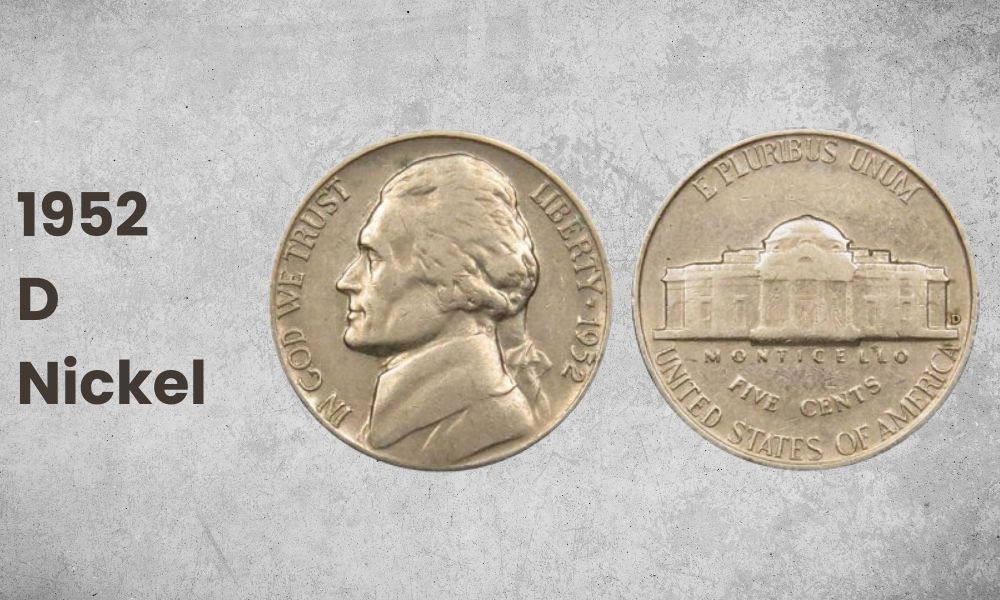
- Type: Jefferson Five Cents (1938-1964)
- Edge: Plain
- Mint Mark: D
- Place of Minting: Denver
- Year of Minting: 1952
- Face Value: $0.05
- $ Price: $0.05 to $2.53
- Quantity Produced: 30,638,000
- Designer: Felix Schlag
The 1952 D nickel was produced at the Denver mint, and it’s much more difficult to track one down than an unmarked nickel from this year.
Despite this, most are still weighed down to their face value. Some better preserved nickels may sell for $0.25 to $0.75 if you’re lucky, but it’s only uncirculated coins that sell for $2.53 or more.
In 2015, Heritage Auctions saw an MS-67 1952 D nickel sell for $16,450, setting the auction record.
1952 S Nickel Value
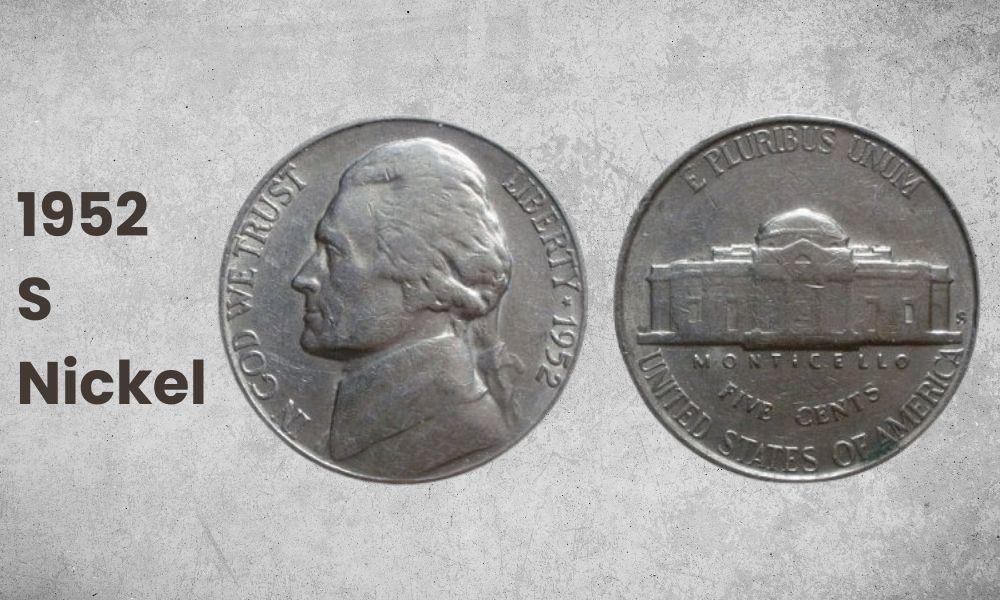
- Type: Jefferson Five Cents (1938-1964)
- Edge: Plain
- Mint Mark: S
- Place of Minting: San Francisco
- Year of Minting: 1952
- Face Value: $0.05
- $ Price: $0.05 to $0.87
- Quantity Produced: 20,572,000
- Designer: Felix Schlag
The 1952 S nickels from the San Francisco mint are the most rare. They not only started with the smallest pool of nickels put into circulation, but many wore out faster than those from other locations.
If you find a 1952 S nickel in very fine condition, you may be able to find a buyer for $0.75. Despite their scarcity, most wouldn’t pay more than face value or a few cents more for this coin.
This is partially due to the low cost of uncirculated pieces from this year. Collectors can easily pay $1,25 to $5 for an uncirculated coin, and they get more from that for only a few dollars more.
Still, perfectly preserved coins hold value well. A 2007 Bowers & Merena auction set an auction record when an MS-66 1952 S nickel sold for $9,488.
1952 Proof Nickel Value
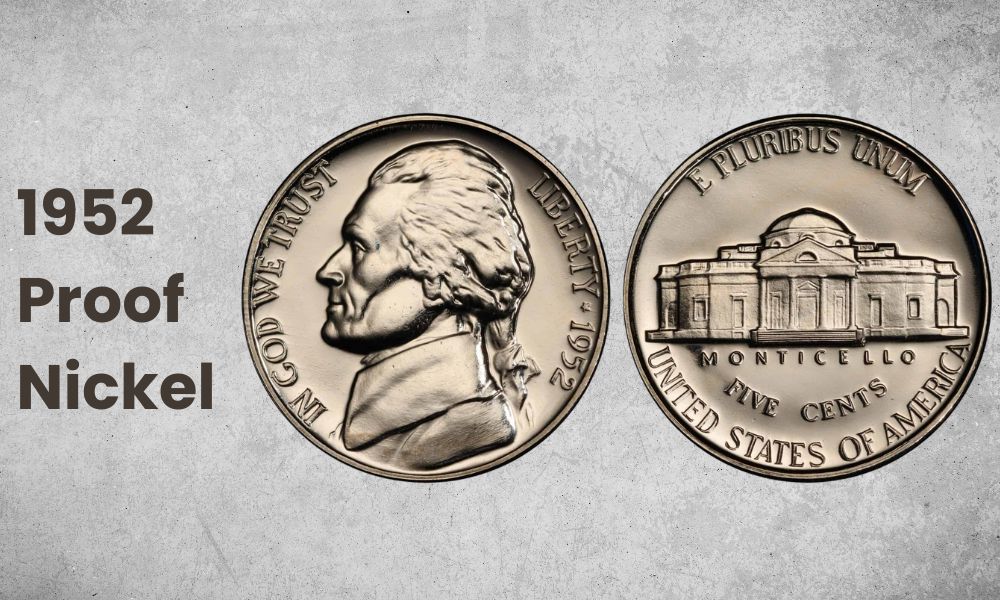
- Type: Jefferson Five Cents (1938-1964)
- Edge: Plain
- Mint Mark: N/A
- Place of Minting: Philadelphia
- Year of Minting: 1952
- Face Value: $0.05
- $ Price: ~$18.00
- Quantity Produced: 81,980
- Designer: Felix Schlag
The 1952 proof nickel easily carries the highest value of five cent coins from this year. These were produced in a limited number and included in 1952 proof sets.
As a general rule, all 81,980 proof nickels from the Philadelphia mint in 1952 feature a phenomenal strike, highly reflective surface, and incredible details. As long as collectors have kept up with them, these coins easily rake in $18 or more.
Also Read: Top 110 Most Valuable Nickels Worth Money
1952 Nickel History
The 1952 nickel is part of the Jefferson nickel series that replaced the Buffalo Nickel in 1939. Franklin D. Roosevelt, president at that time, greatly admired Thomas Jefferson, and the U.S. Mint decided on a contest to design a coin featuring his profile.
German immigrant Felix Schlag won the contest and spent four long weeks refining the design. He designed Jefferson’s profile off a Gilbert Stuart portrait and spent some time revising his different depictions of the Monticello mansion.
Once the design was approved and then released in 1938, it remained mostly untouched through its 66 year run. The major changes occurred during WWII, when coin composition was adjusted so the nickel could be used for military purposes.
The reverse design was replaced by the Westward Journey Nickel Series, but quickly went back to a refined Return to Monticello design.
Also Read: Top 19 Most Valuable Jefferson Nickels Worth Money
1952 Nickel Grading
The 1952 Jefferson nickel is a particularly run-through series, and many of these coins are still in circulation today. The modern market focuses on Mint-State coins according to the PCGS grading standards, but that shouldn’t stop you from judging coins you find interesting.
If you’re looking for a number grade for your coin or you encounter a coin claiming to be uncirculated, make sure you consult a professional numismatist with experience in coin grading. The “Good”, “Fine”, and “Extremely Fine” buckets are not a solid standard for placing true value on these coins, especially rare ones.
Good
The demand for Jefferson nickels is not enough to make “Good” condition coins desirable yet, but knowing how to distinguish them is important.
Coins reach this point when all details are gone except for the outlines on major elements. Any medium or high-relief areas have been worn down, and the coin relies on its recesses to hold detail.
On the reverse, Monticello is nearly reduced to a silhouette. Its foundation lays flat, with barely any building detail remaining, and you won’t see any columns or garble on these coins.
Fine
Nineteen fifty-two nickels in “Fine” condition have aged with grace. Bolder lines are still intact, but general wear rids the coins of most higher relief details.
These coins are smooth in these areas, particularly on Jefferson’s hair. The line of his collar may fade into the highest point of his shoulder, and the eye merges with the cheek.
On the reverse, the columns of Monticello are still visible but quite faint. The triangle above the columns merges with the gable, and lines in all areas start to blur.
Extremely Fine
“Extremely Fine” coins carry slight wear, but nothing drastic. Finer details of the hair, the triangle of Monticello, and the foundation of the building are the first affected, but lines remain strong overall.
An “Extremely Fine” 1952 nickel carries far less dirt and grime, if any, than lesser grades.
Uncirculated
An “Uncirculated” 1952 nickel is collector-grade. These coins retain their original luster without any breaks or wear, as even the slightest circulation would dull shine on high points.
Pay attention to obverse details such as Jefferson’s hair or the shine above his eye; these are often the first to go. On the reverse, make sure the columns of Monticello have their luster.
List of 1952 Nickel Errors
The errors common in the 1952 nickel make them a bit more collectible than they would be otherwise. These “errors” are misprints related to the minting process, resulting in several coins sharing the same feature.
The most common 1952 nickel errors acknowledged by professional numismatists include:
- Double dies
- Off center nickels
- Re-punched mint marks
- Die breaks
You may come across another error variation, but you should have it verified before considering the coin valuable or collectible because of it. Usually, it’s safe to assume authenticity for 1952 nickels with these errors.
1952 Double Die Nickels
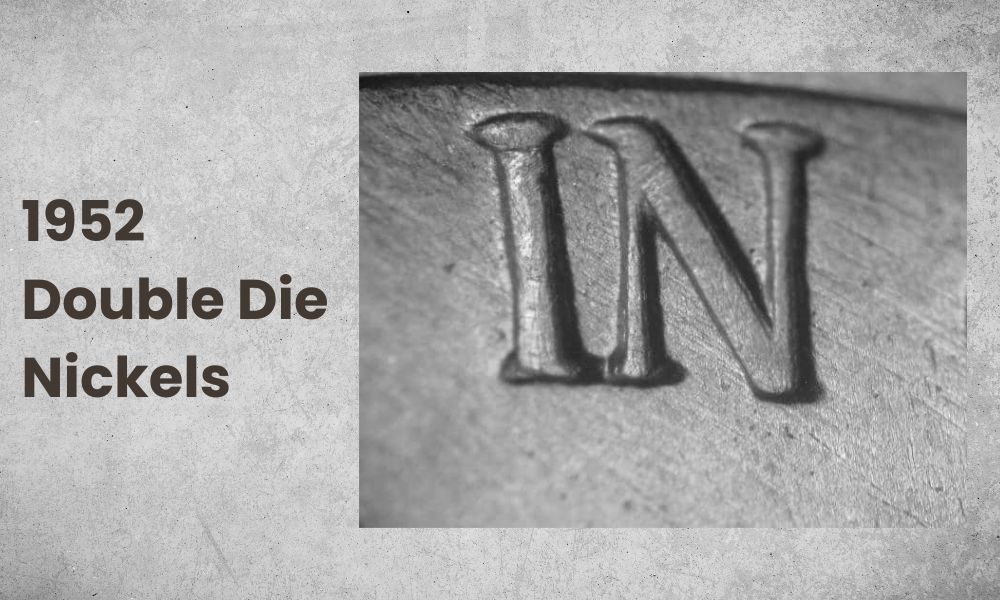
A double die error occurs when the hubbing device presses the working die used to strike the coin twice (and at two different angles). As a result, the coin may have double features on one side of the coin.
For the 1952 nickel, this usually doubles Jefferson’s eye or the reverse inscriptions “MONTICELLO” and “FIVE CENTS”.
While they aren’t super valuable, a double die 1952 nickel may be worth $25 to $50 or more.
1952 Off-Center Nickels
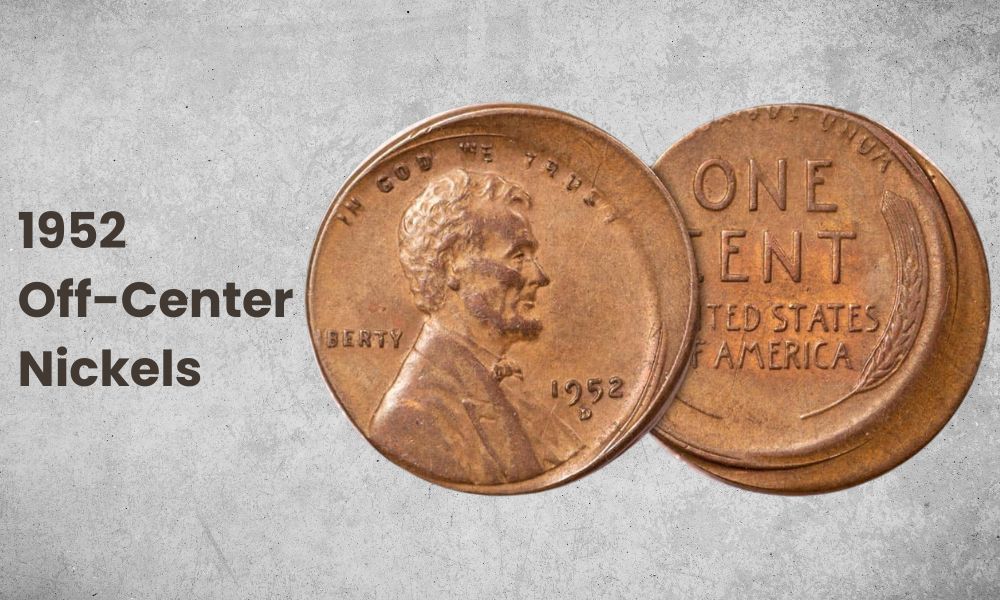
An off-center 1921 nickel is pressed or died when the coin is not properly lined up in the machine. Most off-center errors are only off by 3 to 10 percent, but value increases the further off the coin is marked.
The most desirable off-center coins are those around 50 percent offset. These coins can still show important details like the year and mintmark that properly identify them, and 1921 nickels off center this much are worth $100+.
1952 Re-punched Mint Mark Nickels
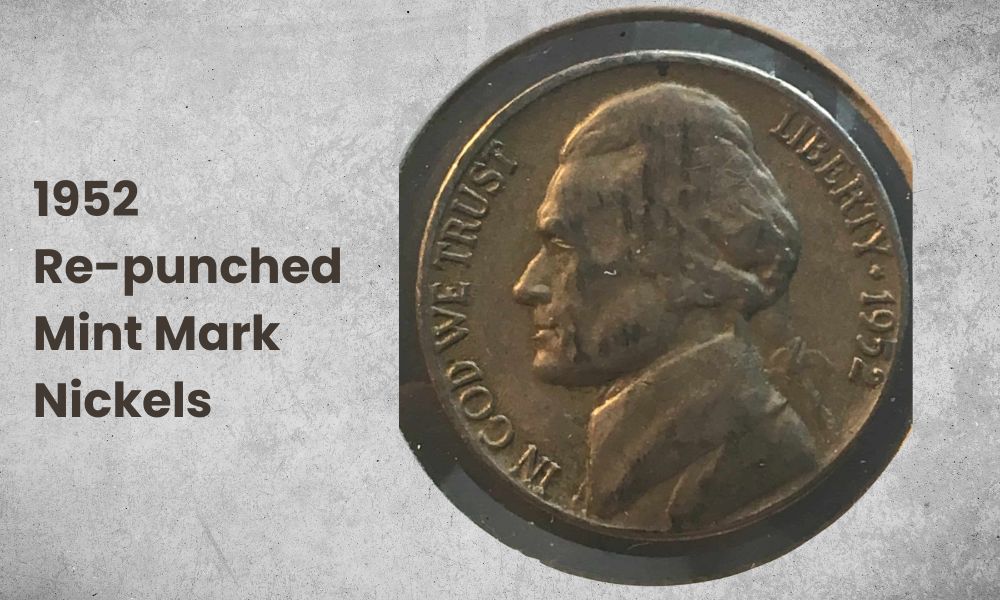
While we had been marking coins for decades by the time 1952 hit, we were still hand punching each working die at this time. This left plenty of room for human error, including tilted or upside down mint marks.
Because the mark needed to sit a certain way, and throwing the coins away was wasteful, you’ll find several with a second mint mark re-punched in the correct position.
Depending whether your 1921 nickel is from the Denver or San Francisco mint, this error usually bumps value up to $5 or $10. More drastic mistakes attract offers of $20 to $50+.
1952 Die Break Nickels
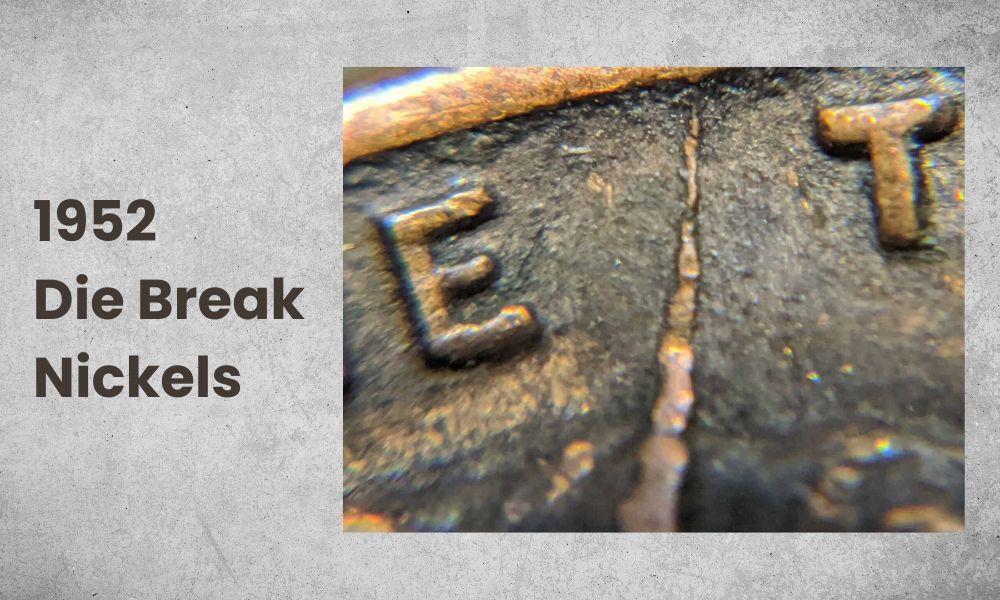
Die break errors were particularly common in 1952 as the coin making die aged and deteriorated, causing significant cracks in the piece. While they were still functional, the damaged die left its mark on the coins it touched, and you see these in the form of:
- Raised lines
- Bumps
- Chips
Like other errors, value increases with the severity of the change from the original coin design. Your 1952 nickel with a minor die break may be worth $3 to $15, while larger changes like die cuds (when the break attaches to the coin’s rim) are worth over $100.
1952 Nickel FAQs
Does a 1952 Nickel Have Silver?
A 1952 nickel does not have silver. Nickels from this year are composed of 75 percent copper and 25 percent nickel. The only five cent coins containing silver were minted during WWII (known as silver war nickels); these have 35 percent silver content.
Where is the Mint Mark on a 1952 Nickel?
The mint mark on a 1952 nickel is located to the right of the Monticello on the reverse of the coin. Nickels minted in Philadelphia do not have a mint mark.
How Much is a 1952 Nickel S Mint Mark Worth?
A 1952 S mint mark nickel is worth about $0.87 in uncirculated condition. This amount may increase or decrease depending on the coin, appraiser, and any errors.
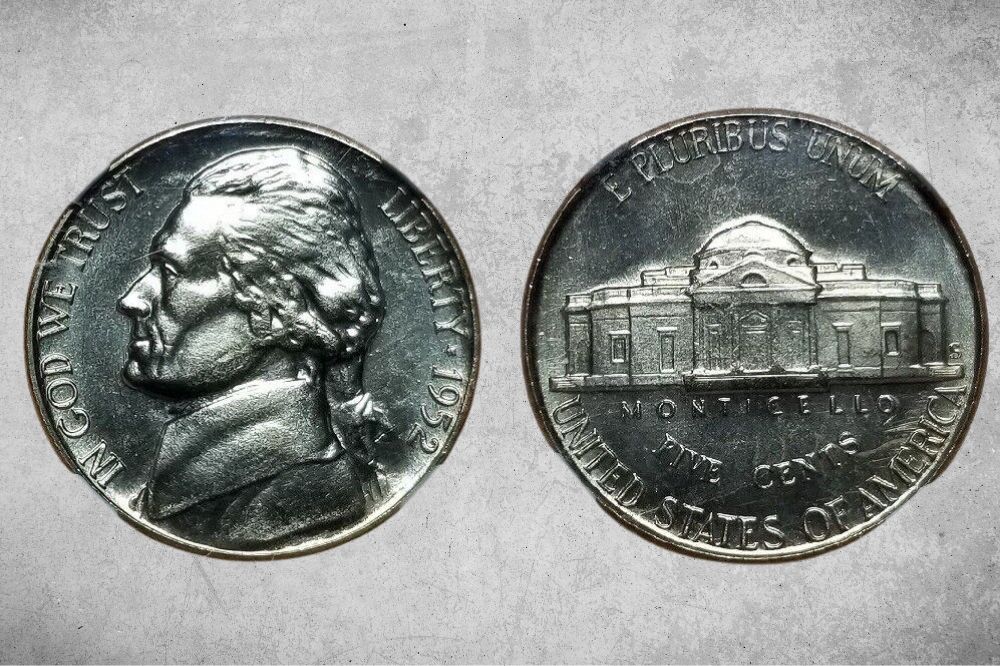
Have a 1952 no mint mark but with extra nickel around the nickel.